Just as Hou Hsiao-hsien’s (侯孝賢) movie City of Sadness (悲情城市) put Jiufen on the tourist map, an award-winning 2004 documentary called Let It Be (無米樂) gave a considerable boost to Houbi District (後壁區) in Tainan City.
The latter depicts the lives of three elderly rice farmers in Houbi around the time of Taiwan’s accession to the WTO in 2002. The film’s Chinese title, literally “happiness without rice,” alludes to the government subsidies farmers receive if they leave their land fallow, which gives them an income without having to labor in their fields. At the same time, it questions the health of a society that allows its agricultural sector to wither.
The documentary also provides glimpses of rural lifestyles and traditional thinking. In an especially endearing scene, one of the farmers gently chides his granddaughter for not eating every grain in her bowl, telling her that a girl who doesn’t finish her rice is fated to marry a man with a pockmarked face.
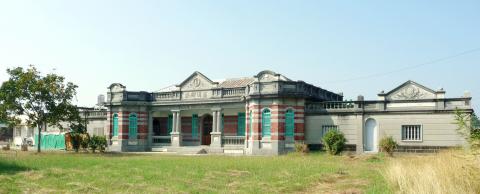
Photo: Steven Crook
Houbi continues to be one of the better places to see how rice cultivation has shaped much of Taiwan’s lowlands, and also how mechanization has replaced much of the drudgery associated with farming.
At this time of year, rice seedlings are being grown in fields, but not in the actual soil. Seeds are sown in shallow plastic boxes the size of food trays; when the seedlings have reached several centimeters in height, the boxes are emptied. The contents of each tray comes out like a single piece of thick carpet, the seedlings being held in place by a mattress of roots. Each rectangle is rolled up by hand, then sent by conveyor belt from the field to a waiting truck.
Specially designed vehicles are used to plant and harvest. However, because these can’t maneuver into the corners of fields, some hand-planting is always needed.

Photo: Steven Crook
RICE PRODUCTION
Back when the agriculturalists featured in Let It Be were infants, most of Taiwan’s rice farmers grew long-grain indica accessions that Mandarin speakers call zailaimi (在來米). Thanks to irrigation projects initiated by the Japanese colonial authorities (who ruled Taiwan from 1895 to 1945), there was a healthy rice surplus. Most of this was shipped to Japan, which for decades had struggled to feed itself.
Unfortunately, consumers in Japan weren’t too fond of Taiwanese grain. They were used to shorter, stickier japonica rice. After Japanese researchers in Taipei succeeded in creating japonica cultivars that would thrive in Taiwan’s conditions, what’s now known as penglaimi (蓬萊米, spelled ponlai on cans of Taiwan Beer) became — and continues to be — the main grain crop.
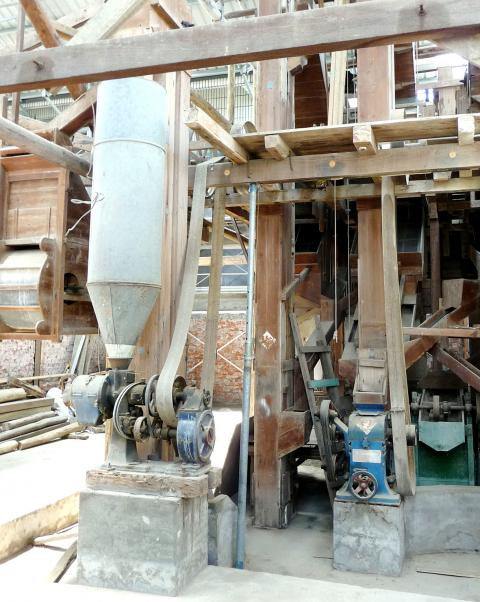
Photo: Steven Crook
Taiwanese rice is expensive by global standards and thus difficult to export. The main threat to the local rice industry isn’t the loss of land due to urban sprawl, or even climate change. (There’s some evidence that global warming is causing rice yields to decline; at the same time, methane and nitrous oxide emissions from paddy fields are one of the factors driving climate change.)
The main issue is that Taiwanese no longer eat much rice. In the 19th century, annual per capita rice consumption may have approached 200kg. Until the 1980s, it was over 100kg. But in recent years, as wheat, potatoes and other imported alternatives have become more affordable, intake has tumbled. It’s now below the global average of 54kg per person per year. Japan and South Korea are at least as affluent as Taiwan, but in neither country have the people turned their back on their traditional carbohydrate to anything like the same extent.
PICTURESQUE VILLAGES
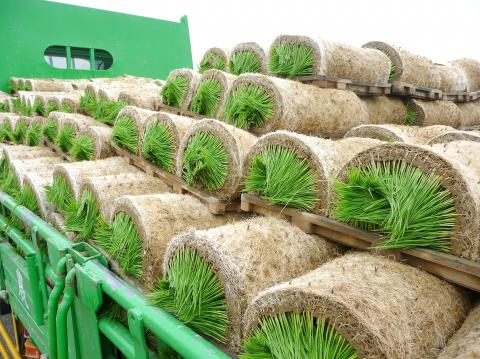
Photo: Steven Crook
Much of Let It Be was filmed around Jingliao Village (菁寮), which has since adopted Wumile as a secondary toponym. Visitors wanting to pick up a map of the area, rent a bicycle, or refill their water bottles, can do so at Wumile Tourist Information Center (無米樂旅遊服務中心).
Many visitors go first to Jingliao Old Street (菁寮老街), where there’s an exceptionally picturesque herbalist’s store at number 191. In fact, the village is full of attractive traditional houses.
Self-driving tourists approaching Jingliao from Chiayi County can take Local Road 85 (南85). When they reach the intersection with Local Road 84 (南84), on the right they’ll see the Yichang Rice Mill (義昌碾米廠). The mill, which was built sometime before 1945, is undergoing renovation. If the doorway is open and you’re brazen, you can check on the project’s progress, and see some of the milling and bagging machinery.
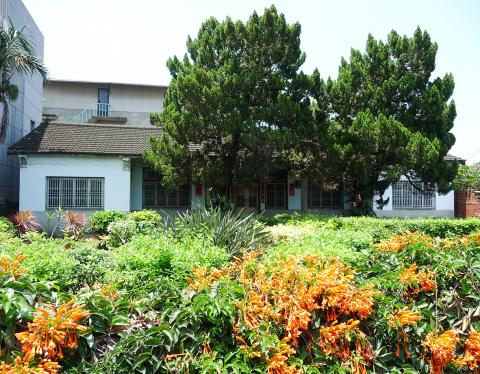
Photo: Steven Crook
On the same side of the road at number 235 stands the Former Residence of Lee Lian-chun (李連春糧食局長家). A small sign outside this modest, single-story home (which is not open to the public) provides a few details about Li’s life.
Lee (1904-2001) began working in the grain industry during the Japanese era. In 1946, he was appointed deputy director of Taiwan Provincial Government’s Grain Bureau. By the time the KMT retreated to Taiwan in 1949, bringing with them more than a million refugees, he was in charge of the bureau.
Faced with a sudden increase in the population that needed feeding, Lee led efforts to increase rice yields and find additional land for food production. He’s credited with averting a crisis, and led the bureau for a total of 24 years.
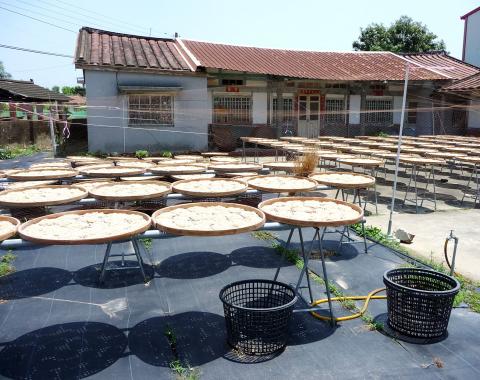
Photo: Steven Crook
Ansiliao (安溪寮) gets far fewer visitors than Jingliao. When I cycled through this sizable village last year, I spotted a building that screamed “old movie theater” so loudly I had to stop and take a look. My hunch was right; the timeworn, Art Deco-influenced facade was that of Jinzi Movie Theater (金紫戲院).
According to one history of the building, a few years after it was completed in 1956, a retired railway official surnamed Wu (吳) and his wife began renting the place for NT$350 per month. They screened locally-made films and hosted budaixi (布袋戲) puppetry performances.
For a while business was good, but by the early 1970s the popularity of television was eating into revenues. Having lost their original home in Chiayi City, the Wu family converted the theater into living quarters. Later, sometime in the early 1980s, the building was repurposed yet again, this time into a leather workshop.
Like many post-war buildings in Taiwan, its historical value has been recognized, but no restoration has been attempted. But I won’t be surprised if, in a few years, I come back and find it’s been turned into a restaurant or a studio.
Steven Crook has been writing about travel, culture, and business in Taiwan since 1996. He is the co-author of A Culinary History of Taipei: Beyond Pork and Ponlai, and author of Taiwan: The Bradt Travel Guide, the third edition of which has just been published.

Following the shock complete failure of all the recall votes against Chinese Nationalist Party (KMT) lawmakers on July 26, pan-blue supporters and the Chinese Communist Party (CCP) were giddy with victory. A notable exception was KMT Chairman Eric Chu (朱立倫), who knew better. At a press conference on July 29, he bowed deeply in gratitude to the voters and said the recalls were “not about which party won or lost, but were a great victory for the Taiwanese voters.” The entire recall process was a disaster for both the KMT and the Democratic Progressive Party (DPP). The only bright spot for

As last month dawned, the Democratic Progressive Party (DPP) was in a good position. The recall campaigns had strong momentum, polling showed many Chinese Nationalist Party (KMT) lawmakers at risk of recall and even the KMT was bracing for losing seats while facing a tsunami of voter fraud investigations. Polling pointed to some of the recalls being a lock for victory. Though in most districts the majority was against recalling their lawmaker, among voters “definitely” planning to vote, there were double-digit margins in favor of recall in at least five districts, with three districts near or above 20 percent in

From Godzilla’s fiery atomic breath to post-apocalyptic anime and harrowing depictions of radiation sickness, the influence of the nuclear bombings of Hiroshima and Nagasaki runs deep in Japanese popular culture. In the 80 years since the World War II attacks, stories of destruction and mutation have been fused with fears around natural disasters and, more recently, the Fukushima crisis. Classic manga and anime series Astro Boy is called “Mighty Atom” in Japanese, while city-leveling explosions loom large in other titles such as Akira, Neon Genesis Evangelion and Attack on Titan. “Living through tremendous pain” and overcoming trauma is a recurrent theme in Japan’s

The great number of islands that make up the Penghu archipelago make it a fascinating place to come back and explore again and again. On your next trip to Penghu, why not get off the beaten path and explore a lesser-traveled outlying island? Jibei Island (吉貝嶼) in Baisha Township (白沙鄉) is a popular destination for its long white sand beach and water activities. However, three other permanently inhabited islands in the township put a unique spin on the traditional Penghu charm, making them great destinations for the curious tourist: Yuanbeiyu (員貝嶼), Niaoyu (鳥嶼) and Dacangyu (大倉嶼). YUANBEIYU Citou Wharf (岐頭碼頭) connects the mainland